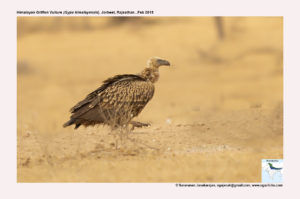Himalayan Griffon Vulture

Himalayan Vulture Gyps himalayensis
Etymology:
- Gyps : Greek word gups – vulture.
- Himalayensis : From himalayas
Vernacular Names: Kash: Grad, H.P:Badagidh, Guj: Ujalogidh
Distribution in India: Resident of Himalayas, winter visitor to North Indian plains.
Description: Size of 103–110 cm; Wt. of 8000–12,000 g; wingspan of 260–290 cm. It is a large, pale vulture; largest of Gypsspecies. It has purplish-pink patch of bare skin at base of neck. The body and wing-coverts are whitish, lacking tawny tones. It haspale bill, largely yellowish; cere is pale brown to greenish brown; irides are pale yellow; feet is greenish grey to whitish. The juvenile is dark, with narrow pale streaks on underparts and upperwing-coverts; irides are light brown; immature plumages are progressively paler overall.
Habitat: It is found in mountains, gorges, high-elevation steppes, mostly 1500–6000 m. In winter comes down to 900m.
Food habits: It eats exclusively on carrion. It soars and glides over vast areas, searching for carcasses and watching other vultures. It gathers in small numbers at carcasses; these can be devoured very rapidly. At carcasses, it is dominant over other vultures, except cinereous vulture. Feeding at times can be raucous, with many grunts and hisses, as vultures fight over a place to feed.
Breeding habits: They breed in Feb–Apr. They build a large nest mostly of reed stalks on cliff ledge or in cavity or small cave; feathers, branch tips and pieces of coloured glass, plastic, bone and ceramic occasionally mixed in with main nest materials. Display flights consist of close mutual soaring of pair. They lay a single-egg clutch. The incubation periodis 50 days. The nestling period is 4–5 months.